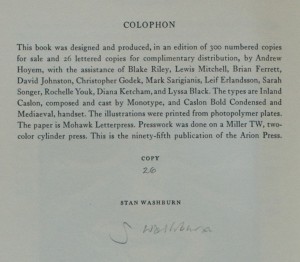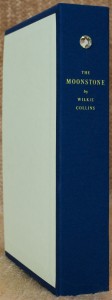
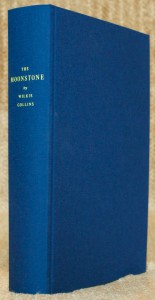 Wilkie Collins is a well known Victorian era British writer of 30 novels, over 60 short stories, 14 plays, as well as a number of non-fiction articles and other pieces. How much of this enormous output have I read? None. I don’t recall any required reading of this good friend of Charles Dickens in any class of mine nor did I ever find a reason to seek him out. Interestingly, he is credited with introducing the detective novel into western canon, with no less than T. S. Eliot calling The Moonstone “the first, the longest, and the best of modern English detective novels.” Another interesting tidbit about the author is that he foresaw the hope that “mutually assured destruction” would somehow teach men to keep the peace in the future. This based on the incredibly destructive European wars of the 19th century. I can imagine his horror in these days of nuclear and biological weapons. The prospectus for the Arion Press edition also notes that he was “one of the best-paid fiction writers of the Victorian era,” an achievement that the author was surely happy about.
Wilkie Collins is a well known Victorian era British writer of 30 novels, over 60 short stories, 14 plays, as well as a number of non-fiction articles and other pieces. How much of this enormous output have I read? None. I don’t recall any required reading of this good friend of Charles Dickens in any class of mine nor did I ever find a reason to seek him out. Interestingly, he is credited with introducing the detective novel into western canon, with no less than T. S. Eliot calling The Moonstone “the first, the longest, and the best of modern English detective novels.” Another interesting tidbit about the author is that he foresaw the hope that “mutually assured destruction” would somehow teach men to keep the peace in the future. This based on the incredibly destructive European wars of the 19th century. I can imagine his horror in these days of nuclear and biological weapons. The prospectus for the Arion Press edition also notes that he was “one of the best-paid fiction writers of the Victorian era,” an achievement that the author was surely happy about.
So The Arion Press continues to lead me to read novels I may have never gotten to otherwise, Collins being the second British novelist they’ve published since I started my subscription with the press. The first subscription book I received was H. G. Wells’ Tono-Bungay, which I have yet to get back around to reviewing as my reading of it predates this blog. All in good time, I suppose, as I may someday run low on fine press books to review.
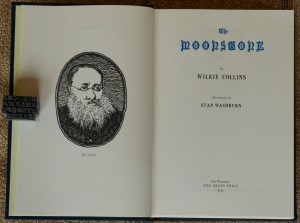 For epistolary novel The Moonstone, Collins uses written narratives from various characters to reconstruct the theft of the famous, cursed diamond after a dinner at the Verinder country estate. As the reader works their way through each narrative, sometimes returning to a character that had dictated their view of the incidents surrounding the mystery earlier in the book. I expect this approach might have been chosen since the original publication was in serial form in Collin’s friend Charles Dickens’ All the Year Round. Regardless of the origin of its form, it works well in The Moonstone, and allows you to really get to know a couple of the characters. Obviously, you also see the same events over and over again but from different sets of eyes, and gradually the events of that night become clear.
For epistolary novel The Moonstone, Collins uses written narratives from various characters to reconstruct the theft of the famous, cursed diamond after a dinner at the Verinder country estate. As the reader works their way through each narrative, sometimes returning to a character that had dictated their view of the incidents surrounding the mystery earlier in the book. I expect this approach might have been chosen since the original publication was in serial form in Collin’s friend Charles Dickens’ All the Year Round. Regardless of the origin of its form, it works well in The Moonstone, and allows you to really get to know a couple of the characters. Obviously, you also see the same events over and over again but from different sets of eyes, and gradually the events of that night become clear.
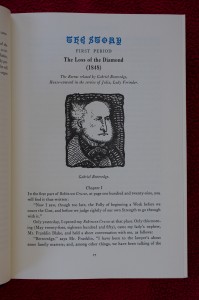 I have to say that my favorite character was the faithful servant, Gabriel Betteredge. He seemed like a character that could easily have appeared in one of Dicken’s novels. One of his most endearing traits was his unwavering faith in a book to guide his life and to be a spiritual and temporal resource in troubling times. No, not the Bible or The Pilgrim’s Progress, but Defoe’s Robinson Crusoe. Who would have thought you could find all the answers there? At one point, not happy with the direction the indefatigable Sergeant Cuff’s investigation was leading, he writes:
I have to say that my favorite character was the faithful servant, Gabriel Betteredge. He seemed like a character that could easily have appeared in one of Dicken’s novels. One of his most endearing traits was his unwavering faith in a book to guide his life and to be a spiritual and temporal resource in troubling times. No, not the Bible or The Pilgrim’s Progress, but Defoe’s Robinson Crusoe. Who would have thought you could find all the answers there? At one point, not happy with the direction the indefatigable Sergeant Cuff’s investigation was leading, he writes:
“Robinson Crusoe—God knows how—had got into my muddled old head. If Sergeant Cuff had found himself, at that moment, transported to a desert island, without a man Friday to keep him company, or a ship to take him off—he would have found himself exactly where I wished him to be! (Nota bene: I am an average good Christian, when you don’t push my Christianity too far. And all the rest of you—which is a great comfort—are, in this respect, much the same as I am.)”
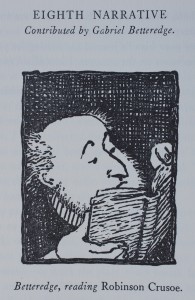 He pulls it out multiple times in the book to show people why events happened the way they did or to help explain some point or the other. When troubled, he Usually likes a nip of something or a smoke with it but he seems to have always been able to rely on it throughout his life and has worn out several editions of it by the time of novel.
He pulls it out multiple times in the book to show people why events happened the way they did or to help explain some point or the other. When troubled, he Usually likes a nip of something or a smoke with it but he seems to have always been able to rely on it throughout his life and has worn out several editions of it by the time of novel.
But he is doesn’t always need to consult Robinson Crusoe to spout some pretty interesting opinions of his own:
“…it is a maxim of mine that men (being superior creatures) are bound to improve women—if they can. When a woman wants me to do anything (my daughter, or not, it doesn’t mater), I always insist on knowing why. The oftener you make them rummage their own minds for a reason, the more manageable you will find them in all the relations of life. It isn’t their fault (poor wretches!) that they act first and think afterwards; it’s the fault of the fools who humor them.”
And:
“I am (thank God!) constitutionally superior to reason. This enabled me to hold firm to my lady’s view, which was my view also. This roused my spirit and made me put a bold face on it before Sergeant Cuff. Profit, good friends, I beseech you, by my example. It will save you from many troubles of the vexing sort. Cultivate a superiority to reason, and see how you pare the claws of all the sensible people when they try to scratch you for your own good!”
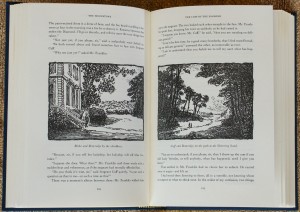 The romantic interest in the novel is provided through the love triangle of the main characters (and cousins!) of Rachel Verinder, Franklin Blake, and Godfrey Ablewhite. All of them at one point or another are prime suspects in the disappearance of the diamond. There is another romantic angle coming from the unlikely and tragic housemaid Rosanna Spearman. And a second reference to a literary classic when the odd medical assistant Ezra Jennings recommends that Franklin consult De Quincey’s Confessions of an English Opium Eater. Sergeant Cuff is notable for his on-going battle with the Verinder’s gardener regarding the care of roses
The romantic interest in the novel is provided through the love triangle of the main characters (and cousins!) of Rachel Verinder, Franklin Blake, and Godfrey Ablewhite. All of them at one point or another are prime suspects in the disappearance of the diamond. There is another romantic angle coming from the unlikely and tragic housemaid Rosanna Spearman. And a second reference to a literary classic when the odd medical assistant Ezra Jennings recommends that Franklin consult De Quincey’s Confessions of an English Opium Eater. Sergeant Cuff is notable for his on-going battle with the Verinder’s gardener regarding the care of roses
“I haven’t much time to be fond of anything, but when I have a moment’s fondness to bestow, most times, Mr. Betteredge, the roses get it.”
And for such observations of during his investigation as this gem:
“If you will look about you (which most people won’t do),” says Sergeant Cuff, “you will see that the nature of a man’s tastes is, most times, as opposite as possible to the nature of a man’s business.”
Overall, Collins develops quite an interesting cast of characters.
The Moonstone was an entertaining and interesting read into the origins of the modern detective novel. I was happy to have the excuse to read it provided by the Arion Press. The story definitely deserves the fine press treatment, so let’s now look at the Arion Press edition in more detail to flesh out The Whole Book Experience.
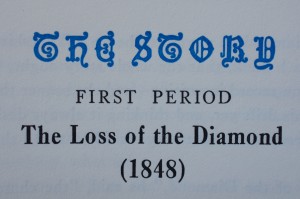 As some of you may have read in my previous post, I was lucky to get a glimpse of the book in production when visiting the press, so that adds a bit of fondness to the edition right away. The overall design of the book is very nice. The Mohawk Letterpress paper feels really nice to the touch and has a nice subtle aroma. (I really love the smell of good paper!). The printing in two colors and the yellow endpapers are a very nice touch, as is the Swarovski crystal “moonstone” on the spine of the slipcase. The deep blue cloth used on the binding is very striking. I also like the way the fore-edge of the text block mimics the curvature of the spine and how the pages are not all trimmed evenly.
As some of you may have read in my previous post, I was lucky to get a glimpse of the book in production when visiting the press, so that adds a bit of fondness to the edition right away. The overall design of the book is very nice. The Mohawk Letterpress paper feels really nice to the touch and has a nice subtle aroma. (I really love the smell of good paper!). The printing in two colors and the yellow endpapers are a very nice touch, as is the Swarovski crystal “moonstone” on the spine of the slipcase. The deep blue cloth used on the binding is very striking. I also like the way the fore-edge of the text block mimics the curvature of the spine and how the pages are not all trimmed evenly.
The illustrations are excellent and the illustrator well chosen in Stan Washburn. I think the head-shot illustrations work especially well with the narratives from various characters. The Betteredge illustrations are my favorites, of course.
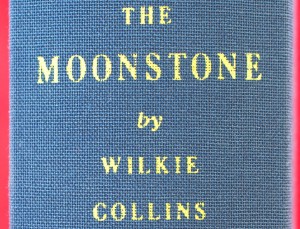 On the negative side, I do sometimes feel like the slipcases on Arion Press books are afterthoughts. This one is designed nicely but just not very sturdy. I wonder if it will hold up as well as the 74 year old slipcase on my Limited Editions Club Les Miserables? Especially if it passes through a couple 2nd hand bookshops like my Les Mis did. Definitely not. I love slipcases so I’d rather have a flimsy one than none but would like to see the Arion Press beef them up a little more. I know they can do it because the slipcases for Sappho, Don Quixote, and The Structure of Rime, to name a few, are excellent. I also noticed more typos than I’m used to, even if they were only a handful in total. And a finally nit, the titling on the spine seems like it could have been more heavily weighted or, better yet, utilized a spine label so that it stood out more.
On the negative side, I do sometimes feel like the slipcases on Arion Press books are afterthoughts. This one is designed nicely but just not very sturdy. I wonder if it will hold up as well as the 74 year old slipcase on my Limited Editions Club Les Miserables? Especially if it passes through a couple 2nd hand bookshops like my Les Mis did. Definitely not. I love slipcases so I’d rather have a flimsy one than none but would like to see the Arion Press beef them up a little more. I know they can do it because the slipcases for Sappho, Don Quixote, and The Structure of Rime, to name a few, are excellent. I also noticed more typos than I’m used to, even if they were only a handful in total. And a finally nit, the titling on the spine seems like it could have been more heavily weighted or, better yet, utilized a spine label so that it stood out more.
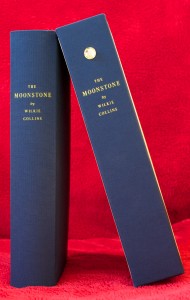 But overall, another quality edition from The Arion Press that captures that Whole Book Experience I look for in fine press. I’m admittedly spoiled in owning several Arion Press editions so the little quibbles I have with a book like this probably have more to do with comparisons with some of the Arion Press masterpieces I own and would be unnoticed in the joy of reading The Moonstone were it my only Arion Press Book.
But overall, another quality edition from The Arion Press that captures that Whole Book Experience I look for in fine press. I’m admittedly spoiled in owning several Arion Press editions so the little quibbles I have with a book like this probably have more to do with comparisons with some of the Arion Press masterpieces I own and would be unnoticed in the joy of reading The Moonstone were it my only Arion Press Book.
AVAILABILITY: As this book is part of the 2012 Subscriber series, it is available directly from the Arion Press. It was issued in an edition of 300 numbered copies for sale, all signed by the artist.


